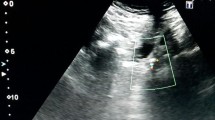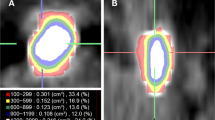Abstract
The aim of this study was to retrospectively evaluate the value of the color Doppler flow imaging mode compared to the gray-scale mode for diagnosing mid-ureteric stones larger than 5 mm. We consecutively collected images from 79 patients possibly suffering from mid-ureteric stones under gray-scale and color Doppler flow imaging modes. Using computed tomography as the gold standard, all the included images were reviewed in a blinded manner for the confirmation of ureteral stones by 15 physicians divided into three groups according to their clinical experience level (resident, attending, and senior). During the evaluation process, the evaluation consistency was calculated and compared using Kendall’s coefficient of concordance (Kendall’s W). Moreover, diagnostic performance considering gray-scale and color imaging modes was compared. Especially for the diagnosis of mid-ureteric stones larger than 5 mm, the Kendall’s W for the combined gray-scale and color Doppler flow imaging ultrasound scanning modes was greater than that for the gray-scale mode (P < 0.05). Additionally, significant improvements in the diagnostic sensitivity, negative predictive value, and accuracy were noted with color Doppler imaging (P < 0.05). Under isolated gray-scale mode, the resident group had reduced diagnostic sensitivity and negative predictive value and poorer accuracy compared with the attending and senior groups (P < 0.05). In contrast, no significant differences in the combined gray-scale and color Doppler flow imaging modes were noted among all groups (P > 0.05). In summary, the color Doppler flow imaging mode is useful for the diagnosis of mid-ureteric stones larger than 5 mm, especially in the resident group.




Similar content being viewed by others
References
Schoenfeld D, Mohn L, Agalliu I, Stern JM (2019) Disparities in care among patients presenting to the emergency department for urinary stone disease. Urolithiasis 48:217–225
Turk C, Petrik A, Sarica K et al (2016) EAU guidelines on diagnosis and conservative management of urolithiasis. Eur Urol 69:468–474
Smith-Bindman R, Aubin C, Bailitz J et al (2014) Ultrasonography versus computed tomography for suspected nephrolithiasis. N Engl J Med 371:1100–1110
Rahmouni A, Bargoin R, Herment A et al (1996) Color Doppler twinkling artifact in hyperechoic regions. Radiology 199:269–271
Liu N, Zhang Y, Shan K et al (2020) Sonographic twinkling artifact for diagnosis of acute ureteral calculus. World J Urol 38:489–495
Wang M, Ma Q, Chen Y et al (2019) The value of shadowing and the twinkling artifact in the diagnosis of ureteral stones: a single center Study. Urology 126:39–44
Sen V, Imamoglu C, Kucukturkmen I et al (2017) Can Doppler ultrasonography twinkling artifact be used as an alternative imaging modality to non-contrast-enhanced computed tomography in patients with ureteral stones? A prospective clinical study. Urolithiasis 45:215–219
Abdel-Gawad M, Kadasne RD, Elsobky E et al (2016) A prospective comparative study of color Doppler ultrasound with twinkling and noncontrast computerized tomography for the evaluation of acute renal colic. J Urol 196:757–762
Masch WR, Cohan RH, Ellis JH et al (2016) Clinical effectiveness of prospectively reported sonographic twinkling artifact for the diagnosis of renal calculus in patients without known urolithiasis. AJR Am J Roentgenol 206:326–331
Korkmaz M, Aras B, Sanal B et al (2014) Investigating the clinical significance of twinkling artifacts in patients with urolithiasis smaller than 5 mm. Jpn J Radiol 32:482–486
Sorensen MD, Harper JD, His RS et al (2013) B-mode ultrasound versus color Doppler twinkling artifact in detecting kidney stones. J Endourol 27:149–153
Ripolles T, Martinez-Perez MJ, Vizuete J et al (2013) Sonographic diagnosis of symptomatic ureteral calculi: usefulness of the twinkling artifact. Abdom Imaging 38:863–869
Kielar AZ, Shabana W, Vakili M et al (2012) Prospective evaluation of Doppler sonography to detect the twinkling artifact versus unenhanced computed tomography for identifying urinary tract calculi. J Ultrasound Med 31:1619–1625
Dillman JR, Kappil M, Weadock WJ et al (2011) Sonographic twinkling artifact for renal calculus detection: correlation with CT. Radiology 259:911–916
Brisbane W, Bailey MR, Sorensen MD (2016) An overview of kidney stone imaging techniques. Nat Rev Urol 13:654–662
Wang M, Li J, Xiao J et al (2011) Systematic analysis of factors related to display of the twinkling artifact by a phantom: an optimized investigation. J Ultrasound Med 30:1449–1457
Field AP (2005) Kendall's Coefficient of Concordance. Encyclopedia of Statistics in Behavioral Science, vol 2. John Wiley & Sons, Ltd., Chichester, pp 1010–1011
Daudon M, Jungers P, Bazin D, Williams JC Jr (2018) Recurrence rates of urinary calculi according to stone composition and morphology. Urolithiasis 46:459–470
Turrin A, Minola P, Costa F et al (2007) Diagnostic value of colour Doppler twinkling artefact in sites negative for stones on B mode renal sonography. Urol Res 35:313–317
Lee JY, Kim SH, Cho JY et al (2001) Color and power Doppler twinkling artifacts from urinary stones: clinical observations and phantom studies. AJR Am J Roentgenol 176:1441–1445
Park SJ, Yi BH, Lee HK et al (2008) Evaluation of patients with suspected ureteral calculi using sonography as an initial diagnostic tool: how can we improve diagnostic accuracy? J Ultrasound Med 27:1441–1450
Davran R (2009) The usefulness of color Doppler twinkling artifact in the diagnosis of urinary calculi. Eur J Radiol 71:378
Trillaud H, Pariente JL, Rabie A et al (2001) Detection of encrusted indwelling ureteral stents using a twinkling artifact revealed on color Doppler sonography. AJR Am J Roentgenol 176:1446–1448
Campbell SC, Cullinan JA, Rubens DJ (2004) Slow flow or no flow? Color and power Doppler US pitfalls in the abdomen and pelvis. Radiographics 24:497–506
Yanik B, Conkbayir I, Cakmakci E et al (2005) Color Doppler twinkling artifact in a calcified liver mass. J Clin Ultrasound 33:474–476
Kim HC, Yang DM, Jin W et al (2010) Color Doppler twinkling artifacts in various conditions during abdominal and pelvic sonography. J Ultrasound Med 29:621–632
Mitterberger M, Aigner F, Pallwein L et al (2009) Sonographic detection of renal and ureteral stones. value of the twinkling sign. Int Braz J Urol 35:532–539
Winkel RR, Kalhauge A, Fredfeldt KE (2012) The usefulness of ultrasound colour-doppler twinkling artefact for detecting urolithiasis compared with low dose nonenhanced computerized tomography. Ultrasound Med Biol 38:1180–1187
Goertz JK, Lotterman S (2010) Can the degree of hydronephrosis on ultrasound predict kidney stone size? Am J Emerg Med 28:813–816
Alan C, Kocoglu H, Kosar S et al (2011) Role of twinkling artifact in characterization of urinary calculi. Actas Urol Esp 35:396–402
Acknowledgements
We would like to convey our appreciation to the 15 participating physicians from the Ultrasonic Imaging Center of The Second Affiliated Hospital of Soochow University for their evaluations and American Journal Experts (AJE) for providing editing assistance for this paper. This work was funded by the Pre-Research Fund for Young Investigators of The Second Affiliated Hospital of Soochow University (SDFEYQN1702); National Key R&D Program of China (2017YFC0909100); the Natural Science Foundation of Jiangsu Province (BK20161222); Science and Technology Development Planning of Shandong Province, China (2012GSF11847); the grant for Key Young Talents of Medicine in Jiangsu (QNRC2016875); and the Humanities and Social Sciences Foundation of the Ministry of Education of China (18YJC910004).
Author information
Authors and Affiliations
Contributions
WM: project development, data collection and analysis, and manuscript writing. LJ, MQ, ZJ, and ZYC: data collection. CY: data collection and analysis, and manuscript writing.
Corresponding author
Ethics declarations
Conflict of interest
We declare no conflicts of interest regarding the content of this manuscript.
Ethical approval
This study was approved by the ethics committee of the Second Affiliated Hospital of Soochow University, and patient consent was waived given the absence of risk.
Additional information
Publisher's Note
Springer Nature remains neutral with regard to jurisdictional claims in published maps and institutional affiliations.
Rights and permissions
About this article
Cite this article
Wang, M., Ma, Q., Chen, Y. et al. Value of the color Doppler imaging mode in improving physicians’ diagnostic performance in patients with mid-ureteric stones larger than 5 mm: a retrospective study. Urolithiasis 49, 463–469 (2021). https://doi.org/10.1007/s00240-021-01250-w
Received:
Accepted:
Published:
Issue Date:
DOI: https://doi.org/10.1007/s00240-021-01250-w




